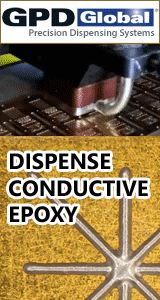Printed Circuit Board Assembly & PCB Design Forum
SMT electronics assembly manufacturing forum.
- SMTnet
- »
- Electronics Forum
- »
- Palladium poor wetting
Palladium poor wetting
Views: 4829
![]() I have read some threads about poor wetting on palladium-sil...
- May 22, 2006
by
I have read some threads about poor wetting on palladium-sil...
- May 22, 2006
by
![]()
![]() No suggestions, but we've also had problems with silver pall...
- May 23, 2006
by
No suggestions, but we've also had problems with silver pall...
- May 23, 2006
by
![]()
![]() Seems as though the problem is with PCB and not component? ...
- May 23, 2006
by
RDR
Seems as though the problem is with PCB and not component? ...
- May 23, 2006
by
RDR
![]()
![]()
![]() Had exactly the same type of issues. Tried everything from p...
- May 23, 2006
by
Had exactly the same type of issues. Tried everything from p...
- May 23, 2006
by
![]()
![]() Sorry I misled you. The PCB pads are wetting, but there is n...
- May 23, 2006
by
Sorry I misled you. The PCB pads are wetting, but there is n...
- May 23, 2006
by
![]()
![]() Not being funny here but I understand exactly what you are s...
- May 23, 2006
by
Not being funny here but I understand exactly what you are s...
- May 23, 2006
by
![]()
![]() They work well in silver conductive epoxy in hybrid applicat...
- May 23, 2006
by
Flipit
They work well in silver conductive epoxy in hybrid applicat...
- May 23, 2006
by
Flipit
![]()
![]()
![]() First, where the temperatures that aare mentioned in the ori...
- May 23, 2006
by
davef
First, where the temperatures that aare mentioned in the ori...
- May 23, 2006
by
davef
![]()
![]()
![]() The temperatures were measured on the board, ~1/2" away from...
- May 24, 2006
by
The temperatures were measured on the board, ~1/2" away from...
- May 24, 2006
by
![]()
![]() Hi
I manufacture ceramic parts that have a terminations tha...
- May 25, 2006
by
Slaine
Hi
I manufacture ceramic parts that have a terminations tha...
- May 25, 2006
by
Slaine
![]()
![]()
![]() The warmest spot you measure on the board is the bare lamina...
- May 25, 2006
by
davef
The warmest spot you measure on the board is the bare lamina...
- May 25, 2006
by
davef
![]()
![]()
![]() Had the same problem with a batch of 0603`s nfrom Vishay.
T...
- May 25, 2006
by
Mark
Had the same problem with a batch of 0603`s nfrom Vishay.
T...
- May 25, 2006
by
Mark
![]()
![]()
![]() Print a number of pads of the 0603 on to a ceramic substrate...
- May 25, 2006
by
Mark
Print a number of pads of the 0603 on to a ceramic substrate...
- May 25, 2006
by
Mark
![]()
Steve
- SMTnet
- »
- Electronics Forum
- »
- Palladium poor wetting







